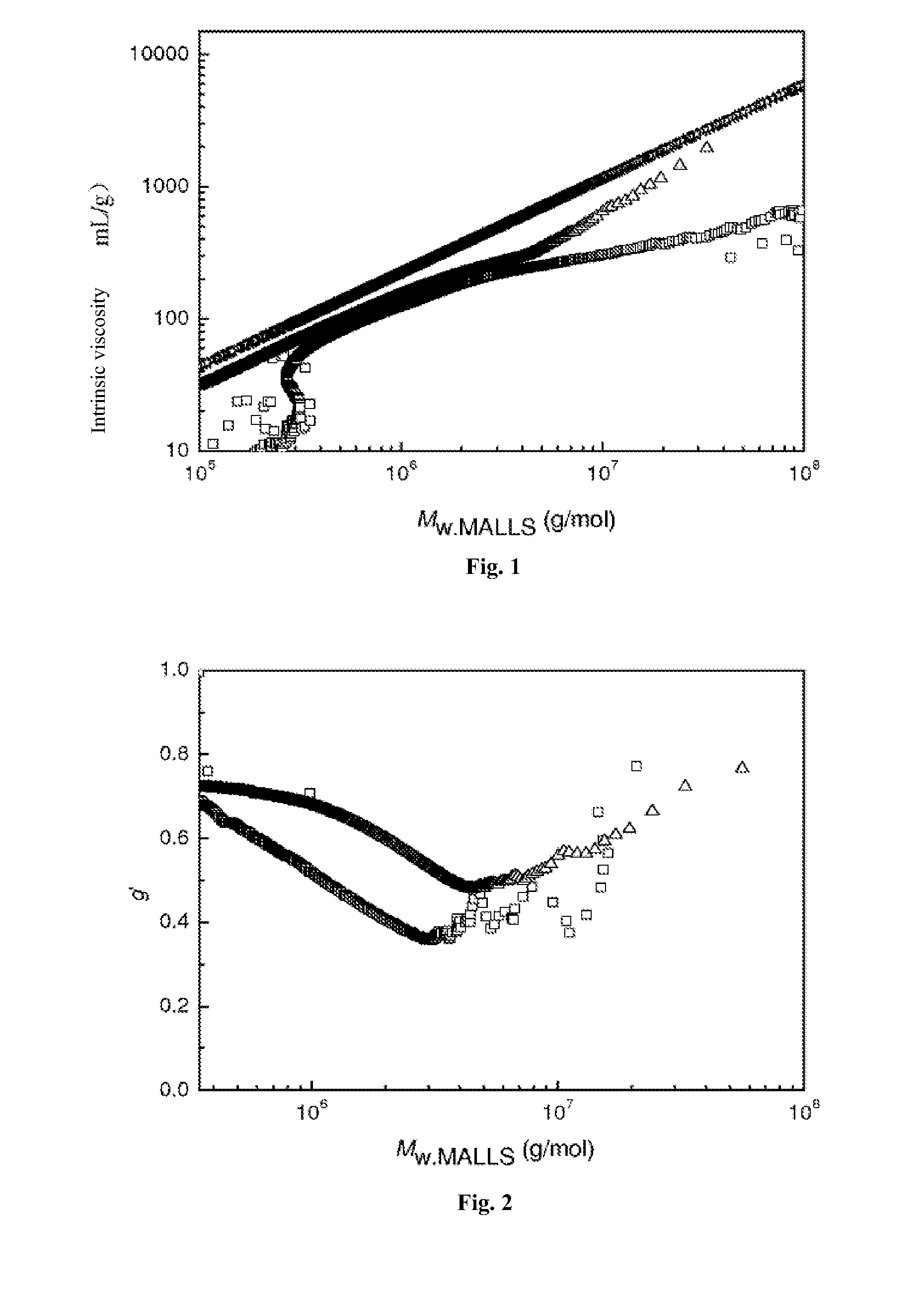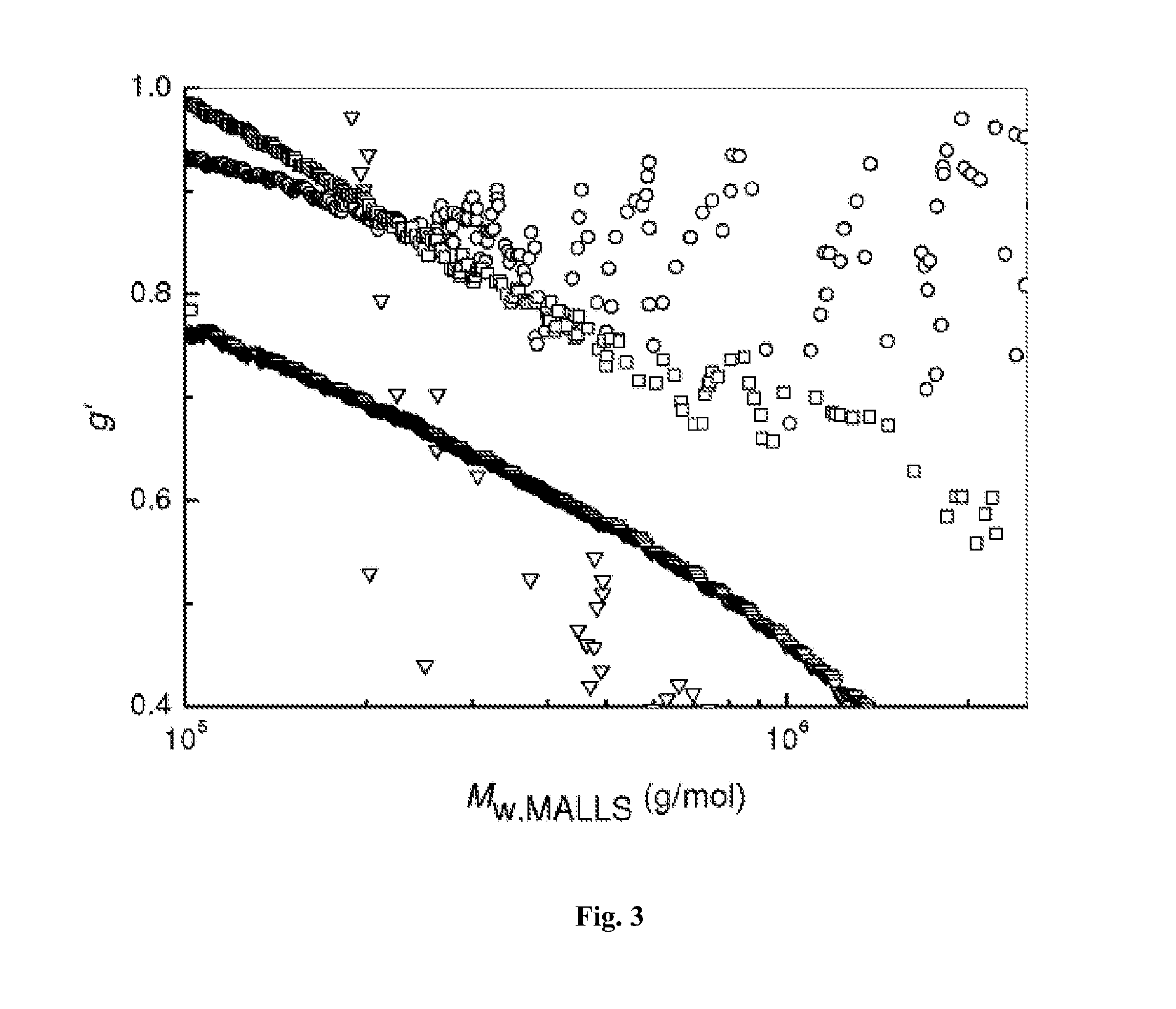Process for preparing branched polymer
a polymer and branched technology, applied in the field of polymer synthesis, can solve the problems of high polymerization reaction cost, difficult to achieve the effect of branched polymerization, simple and practical, and good storage stability
- Summary
- Abstract
- Description
- Claims
- Application Information
AI Technical Summary
Benefits of technology
Problems solved by technology
Method used
Image
Examples
embodiment 1
[0020]Add styrene (St 5.2018 g, 0.05 mol), initiator tert-butyl peroxide methacrylate (0.0396 g, 0.25 mmol) and solvent toluene (1.7325 g) into the reaction flask. They were reacted at 85° C. for 40 h, and the styrene conversion rate was found to be 82.59%. Analyze the polymer with a three-measurement gel permeation chromatograph, and the following result is obtained: light scattering weight-average molecular weight Mw.MALLS=418400, gel permeation chromatography weight-average molecular weight Mw·GPC=253200, molecular weight distribution PDI=4.72, Mark-Houwink index α=0.455, as shown by the Mark-Houwink curve in FIG. 1; average branching factor g′=0.533, which proves that the obtained polymer has branching structure. Refer to FIG. 2 for the variation trend of the branching factor g′ and molecular weight of the branched polymer.
embodiment 2
[0021]Add styrene (5.2102 g, 0.05 mol), initiator tert-butyl peroxide methacrylate (0.0393 g, 0.25 mmol), and solvent toluene (1.7288 g) into the reaction flask. They were reacted at 60° C. for 40 h, and the styrene conversion rate was found to be 65.31%. Analyze the polymer with a three-measurement gel permeation chromatograph, and the following result is obtained: light scattering weight-average molecular weight Mw·MALLS=1284000 g / mol, gel permeation chromatography weight-average molecular weight Mw·GPC=460100 g / mol, molecular weight distribution PDI=4.82, Mark-Houwink index α=0.536, average branching factor g′=0.384, which proves that the obtained polymer has branching structure.
embodiment 3
[0022]Add styrene (5.2099 g, 0.05 mol), initiator isopropylphenyl peroxide methacrylate (0.0527 g, 0.25 mmol), and solvent toluene (1.7348 g) into the reaction flask. They were reacted at 100° C. for 8 h, and the styrene conversion rate was found to be 81.05%. Analyze the polymer with a three-measurement gel permeation chromatograph, and the following result is obtained: light scattering weight-average molecular weight Mw·MALLS=782100 g / mol, gel permeation chromatography weight-average molecular weight Mw·GPC=433900 g / mol, molecular weight distribution PDI=6.69, Mark-Houwink index α=0.576, as shown by the Mark-Houwink curve in FIG. 1; the average branching factor g′=0.658, which proves that the obtained polymer has branching structure. Refer to FIG. 2 for the variation trend of the branching factor g′ and molecular weight of the branched polymer.
PUM
| Property | Measurement | Unit |
|---|---|---|
| temperature | aaaaa | aaaaa |
| temperature | aaaaa | aaaaa |
| temperature | aaaaa | aaaaa |
Abstract
Description
Claims
Application Information
 Login to View More
Login to View More - R&D
- Intellectual Property
- Life Sciences
- Materials
- Tech Scout
- Unparalleled Data Quality
- Higher Quality Content
- 60% Fewer Hallucinations
Browse by: Latest US Patents, China's latest patents, Technical Efficacy Thesaurus, Application Domain, Technology Topic, Popular Technical Reports.
© 2025 PatSnap. All rights reserved.Legal|Privacy policy|Modern Slavery Act Transparency Statement|Sitemap|About US| Contact US: help@patsnap.com



